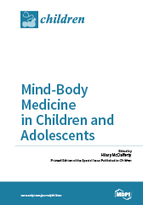Mind-Body Medicine in Children and Adolescents
A special issue of Children (ISSN 2227-9067).
Deadline for manuscript submissions: closed (31 December 2016) | Viewed by 188148
Special Issue Editor
Interests: pain and stress management in the pediatric emergency department; mind–body medicine in children; pediatric integrative medicine; physician wellness; medical education
Special Issues, Collections and Topics in MDPI journals
Special Issue Information
Dear Colleagues,
Mind–body therapies can be described as the deliberate harnessing of positive thought and emotion for use in health and healing. Some mind-body therapies with strongest evidence include biofeedback, clinical hypnosis, guided imagery, music therapy, mindfulness, yoga, and progressive muscle relaxation. In children, the mind-body therapies can expand the range of treatment options by introducing gentle, pharmaceutical –free and flexible complementary therapies in the treatment of common conditions such as acute and chronic pain, anxiety, migraine or tension headache, recurrent abdominal pain, chemotherapy associated side effects, and a range of behavioural and autoimmune-inflammatory driven illnesses. The mind-body therapies can also help address caretaker stress and fatigue. This Special Edition will explore a range of mind-body therapies in children and adolescents with the goal of updating the reader on evolving research in the field and familiarizing them with useful resources for further education and training programs for medical professionals.
Dr. Hilary McClafferty
Guest Editor
Manuscript Submission Information
Manuscripts should be submitted online at www.mdpi.com by registering and logging in to this website. Once you are registered, click here to go to the submission form. Manuscripts can be submitted until the deadline. All submissions that pass pre-check are peer-reviewed. Accepted papers will be published continuously in the journal (as soon as accepted) and will be listed together on the special issue website. Research articles, review articles as well as short communications are invited. For planned papers, a title and short abstract (about 100 words) can be sent to the Editorial Office for announcement on this website.
Submitted manuscripts should not have been published previously, nor be under consideration for publication elsewhere (except conference proceedings papers). All manuscripts are thoroughly refereed through a single-blind peer-review process. A guide for authors and other relevant information for submission of manuscripts is available on the Instructions for Authors page. Children is an international peer-reviewed open access monthly journal published by MDPI.
Please visit the Instructions for Authors page before submitting a manuscript. The Article Processing Charge (APC) for publication in this open access journal is 2400 CHF (Swiss Francs). Submitted papers should be well formatted and use good English. Authors may use MDPI's English editing service prior to publication or during author revisions.
Keywords
- Mind-body therapies
- pain
- headache
- stress
- biofeedback
- hypnosis
- guided imagery
- mindfulness
- yoga
- caretaker stress







